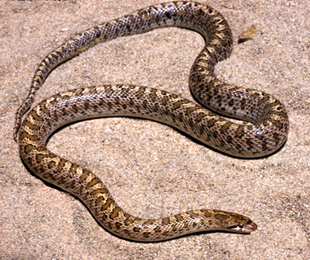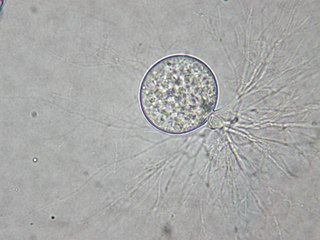
Caenorhabditis elegans is a free-living transparent nematode about 1 mm in length that lives in temperate soil environments. It is the type species of its genus. The name is a blend of the Greek caeno- (recent), rhabditis (rod-like) and Latin elegans (elegant). In 1900, Maupas initially named it Rhabditides elegans. Osche placed it in the subgenus Caenorhabditis in 1952, and in 1955, Dougherty raised Caenorhabditis to the status of genus.

Zinnia is a genus of plants of the tribe Heliantheae within the family Asteraceae. They are native to scrub and dry grassland in an area stretching from the Southwestern United States to South America, with a centre of diversity in Mexico. Members of the genus are notable for their solitary long-stemmed 12 petal flowers that come in a variety of bright colors. The genus name honors German master botanist Johann Gottfried Zinn (1727–59).

Howard Robert Horvitz ForMemRS NAS AAA&S APS NAM is an American biologist best known for his research on the nematode worm Caenorhabditis elegans, for which he was awarded the 2002 Nobel Prize in Physiology or Medicine, together with Sydney Brenner and John E. Sulston, whose "seminal discoveries concerning the genetic regulation of organ development and programmed cell death" were "important for medical research and have shed new light on the pathogenesis of many diseases".

Sir John Edward Sulston was a British biologist and academic who won the Nobel Prize in Physiology or Medicine for his work on the cell lineage and genome of the worm Caenorhabditis elegans in 2002 with his colleagues Sydney Brenner and Robert Horvitz at the MRC Laboratory of Molecular Biology. He was a leader in human genome research and Chair of the Institute for Science, Ethics and Innovation at the University of Manchester. Sulston was in favour of science in the public interest, such as free public access of scientific information and against the patenting of genes and the privatisation of genetic technologies.

Arizona elegans is a species of medium-sized colubrid snake commonly referred to as the glossy snake or the faded snake, which is endemic to the southwestern United States and Mexico. It has several subspecies. Some have recommended that A. elegans occidentalis be granted full species status.

Elmisaurus is an extinct genus of caenagnathid dinosaur from the Late Cretaceous Nemegt Formation of Mongolia. It was a theropod belonging to the Oviraptorosauria.

The ring-tailed vontsira, locally still known as the ring-tailed mongoose, is a euplerid in the subfamily Galidiinae, a carnivoran native to Madagascar. It is the only species in the genus Galidia.

Fungi of the order Chytridiales, like other members of its division, may either have a monocentric thallus or a polycentric rhizomycelium. When the ribosomal genes of members classified in this order were first examined using molecular techniques, it was discovered that the order contained some species that were not related. With the culture and characterization of Chytridium olla, the type species of this order, the limits of the Chytridiales were established. The Chytridiales is now monophyletic and species such as Polychytrium aggregatum, Chytriomyces angularis and Cladochytrium replicatum have been transferred to other orders.

The Nubian flapshell turtle or Nubian soft-shelled turtle is one of two species of softshell turtle in the genus Cyclanorbis of the Trionychidae family. It is thought to have ranged from West Africa east through Central Africa to South Sudan, although it has been extirpated from the vast majority of its range.

The elegant water shrew is a species of mammal in the subfamily Soricinae of the family Soricidae. It is the only species within the genus Nectogale. It lives in Sikkim and China.

Cornelia Isabella "Cori" Bargmann is an American neurobiologist. She is known for her work on the genetic and neural circuit mechanisms of behavior using C. elegans, particularly the mechanisms of olfaction in the worm. She has been elected to the National Academy of Sciences and had been a Howard Hughes Medical Institute investigator at UCSF and then Rockefeller University from 1995 to 2016. She was the Head of Science at the Chan Zuckerberg Initiative from 2016 to 2022. In 2012 she was awarded the $1 million Kavli Prize, and in 2013 the $3 million Breakthrough Prize in Life Sciences.
Chaetonotus elegans is a species of gastrotrichs in the genus Chaetonotus. It is found in freshwater of Europe.

Zinnia elegans known as youth-and-age, common zinnia or elegant zinnia, is an annual flowering plant in the family Asteraceae. It is native to Mexico but grown as an ornamental in many places and naturalised in several places, including scattered locations in South and Central America, the West Indies, the United States, Australia, and Italy.

Apophysomyces variabilis is an emerging fungal pathogen that can cause serious and sometimes fatal infection in humans. This fungus is a soil-dwelling saprobe with tropical to subtropical distribution. It is a zygomycete that causes mucormycosis, an infection in humans brought about by fungi in the order Mucorales. Infectious cases have been reported globally in locations including the Americas, Southeast Asia, India, and Australia. Apophysomyces variabilis infections are not transmissible from person to person.
C. elegans most commonly refers to the model round worm Caenorhabditis elegans. It may also refer to any of the species below. They are listed, first in taxonomic order and, second, alphabetically.

Chytriomyces is the type genus of fungi in the family Chytriomycetaceae. The genus was described by mycologist John Sidney Karling in 1945. The family, created by Peter Letcher in 2011, contains species with a Group I-type zoospore, distinguishing it from Chytridiaceae members, which have a Group II-type zoospore.

Lithocarpus elegans is a tree in the beech family Fagaceae. The specific epithet elegans is from the Latin meaning "elegant", referring to the acorns and cupules.

Bauruemys is an extinct genus of turtles in the family Podocnemididae.

Mariannaea elegans an anamorphic fungus. It is mainly found on rotting wood and soil. M. elegans is not pathogenic to humans, animals, or plants.















